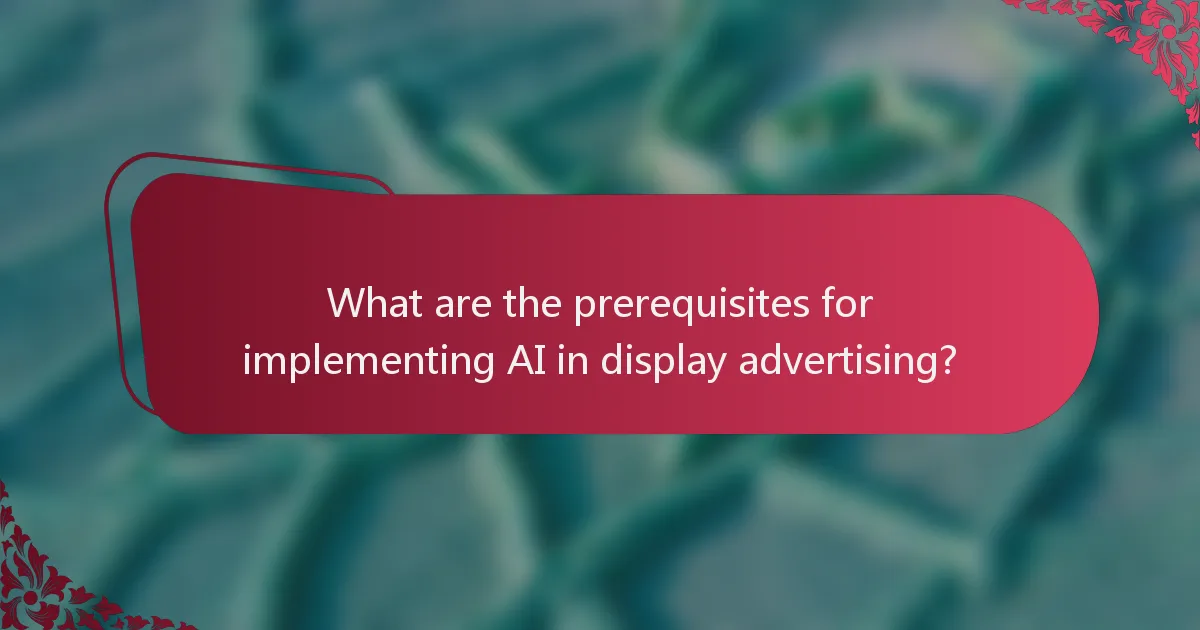Tehisintellekt muudab oluliselt display-reklaamimist Eestis, parandades sihtimise täpsust, automatiseerides reklaamide loomist ja võimaldades reaalajas optimeerimist. Need edusammud aitavad reklaamijatel tõhusamalt jõuda sihtrühmadeni ja parandada kampaaniate üldist tulemuslikkust.

How is AI transforming display advertising in Estonia?
AI is significantly changing display advertising in Estonia by enhancing targeting precision, automating ad creation, and enabling real-time optimization. These advancements allow advertisers to reach specific audiences more effectively and improve overall campaign performance.
Enhanced targeting capabilities
AI enhances targeting capabilities by analyzing vast amounts of data to identify patterns and preferences among consumers. This allows advertisers to create highly personalized ads that resonate with specific demographics, interests, and behaviors.
For instance, Estonian businesses can leverage AI tools to segment their audience based on online behavior, leading to more relevant ad placements. This targeted approach can improve engagement rates and increase conversion opportunities.
Automated ad creation
Automated ad creation powered by AI streamlines the process of generating ad content, reducing the time and resources needed for production. AI algorithms can create variations of ads based on successful templates and audience insights, ensuring that the content is both appealing and relevant.
In Estonia, companies can utilize platforms that offer automated design features, allowing them to quickly produce ads tailored to different segments without sacrificing quality. This efficiency can lead to cost savings and faster campaign launches.
Real-time optimization
Real-time optimization allows advertisers to adjust their campaigns dynamically based on performance data. AI systems can analyze metrics such as click-through rates and conversion rates to make immediate changes to ad placements and budgets.
For Estonian advertisers, this means they can respond quickly to market changes and audience reactions, maximizing their return on investment. Implementing real-time optimization strategies can significantly enhance the effectiveness of display advertising campaigns.

What are the key benefits of AI in display advertising?
AI significantly enhances display advertising by optimizing ad placements, personalizing content, and improving targeting accuracy. These advancements lead to better performance metrics and a more efficient allocation of advertising budgets.
Increased ROI
AI-driven display advertising can substantially increase return on investment (ROI) by analyzing vast amounts of data to identify the most effective ad strategies. By predicting consumer behavior and optimizing ad spend in real-time, businesses can achieve higher conversion rates and lower costs per acquisition.
For example, companies using AI tools may see ROI improvements ranging from 20% to 50% compared to traditional methods. Implementing machine learning algorithms can help advertisers allocate budgets more effectively across various channels, ensuring that funds are directed where they yield the best results.
Improved customer engagement
AI enhances customer engagement by delivering personalized ad experiences tailored to individual preferences and behaviors. By utilizing data analytics, businesses can create dynamic ads that resonate with their target audience, leading to increased interaction and brand loyalty.
For instance, AI can analyze user interactions to determine the optimal time and platform for ad delivery, resulting in higher click-through rates. Advertisers should focus on segmenting their audience and leveraging AI tools to craft compelling messages that speak directly to consumer needs, thereby fostering a deeper connection with their brand.

What strategies should advertisers adopt for AI integration?
Advertisers should focus on leveraging data-driven insights and collaborative tools to effectively integrate AI into their strategies. These approaches enhance targeting, optimize campaigns, and foster teamwork, ultimately leading to improved performance and ROI.
Data-driven decision making
Data-driven decision making involves using analytics and AI algorithms to guide advertising strategies. By analyzing consumer behavior, preferences, and trends, advertisers can create more personalized and effective campaigns. This approach allows for real-time adjustments based on performance metrics.
To implement data-driven strategies, advertisers should invest in robust analytics platforms that can process large datasets. Regularly reviewing key performance indicators (KPIs) such as click-through rates and conversion rates can help refine targeting and messaging.
Collaborative tools
Collaborative tools facilitate seamless communication and project management among teams working on AI-driven advertising campaigns. These tools can include shared dashboards, project management software, and communication platforms that allow for real-time updates and feedback.
Using collaborative tools helps ensure that all team members are aligned on goals and strategies. For instance, utilizing platforms like Slack or Trello can enhance coordination and streamline workflows, making it easier to adapt to changes in campaign performance quickly.

What challenges do advertisers face with AI adoption?
Advertisers encounter several challenges when adopting AI, including data privacy concerns and the need for integration with existing systems. These hurdles can impact the effectiveness of AI-driven campaigns and require careful consideration to navigate successfully.
Data privacy concerns
Data privacy is a significant challenge for advertisers using AI, as they must comply with regulations like the General Data Protection Regulation (GDPR) in Europe. This regulation mandates strict guidelines on how personal data is collected, stored, and used, which can limit the scope of AI applications.
To address these concerns, advertisers should prioritize transparency with users about data usage and implement robust data protection measures. Utilizing anonymized data can help mitigate risks while still allowing for effective targeting.
Integration with existing systems
Integrating AI solutions with current advertising systems can be complex and resource-intensive. Advertisers often face compatibility issues between new AI tools and legacy systems, which can hinder operational efficiency.
To facilitate smoother integration, businesses should assess their existing infrastructure and identify potential gaps before implementing AI. Investing in scalable solutions that can adapt to future needs will also help ensure long-term success in leveraging AI for advertising.

How can display advertisers measure AI effectiveness?
Display advertisers can measure AI effectiveness by analyzing key performance indicators and gathering customer feedback. These methods help determine how well AI-driven strategies are performing and where adjustments may be needed.
Performance metrics
Performance metrics are essential for evaluating the success of AI in display advertising. Key metrics include click-through rates (CTR), conversion rates, and return on ad spend (ROAS). For instance, a CTR increase of 20-30% after implementing AI can indicate improved targeting.
It’s important to set benchmarks before deploying AI tools. Compare pre- and post-AI performance to identify trends and areas for improvement. Regularly review metrics to ensure that the AI system adapts to changing audience behaviors.
Customer feedback analysis
Customer feedback analysis provides valuable insights into how AI impacts user experience. Collecting feedback through surveys or social media can reveal perceptions of ad relevance and engagement. For example, a survey might show that 70% of respondents find AI-generated ads more appealing.
Utilize sentiment analysis tools to process large volumes of feedback efficiently. This can help identify common themes and areas where AI may need refinement. Regularly integrating customer insights into strategy adjustments can enhance overall effectiveness.

What are the prerequisites for implementing AI in display advertising?
Implementing AI in display advertising requires a robust data infrastructure and a skilled workforce. These elements are essential for leveraging AI technologies effectively and ensuring successful advertising strategies.
Data infrastructure
A strong data infrastructure is crucial for AI in display advertising, as it enables the collection, storage, and analysis of large datasets. Companies should invest in scalable cloud solutions and data management systems to handle the volume and variety of data generated from various advertising channels.
Additionally, ensuring data quality is vital. This includes regular audits and cleaning processes to eliminate inaccuracies and redundancies. A well-structured database allows for efficient data retrieval and processing, which is essential for real-time AI applications.
Skilled workforce
Having a skilled workforce is another key prerequisite for implementing AI in display advertising. This includes data scientists, machine learning engineers, and digital marketing professionals who understand both AI technologies and advertising strategies. Training programs and workshops can help upskill existing employees in these areas.
Moreover, fostering a culture of collaboration between technical and marketing teams can enhance the effectiveness of AI initiatives. Regular communication ensures that AI tools are aligned with marketing goals, leading to more targeted and effective advertising campaigns.

What tools are available for AI-driven display advertising?
AI-driven display advertising utilizes various tools that enhance targeting, optimization, and creative processes. Key platforms like Google Ads and Adobe Advertising Cloud leverage artificial intelligence to improve ad performance and efficiency.
Google Ads AI features
Google Ads incorporates several AI features designed to optimize display advertising. Smart Bidding, for example, uses machine learning to adjust bids in real-time based on user behavior and context, aiming to maximize conversions within a specified budget.
Additionally, Responsive Display Ads automatically adjust their size, appearance, and format to fit different ad spaces, ensuring broader reach. Advertisers can input multiple headlines and descriptions, allowing Google’s AI to test combinations and determine the most effective ones.
Adobe Advertising Cloud
Adobe Advertising Cloud offers a comprehensive suite of tools for managing display advertising with AI capabilities. Its machine learning algorithms analyze vast amounts of data to optimize ad placements and targeting, helping advertisers reach the right audience at the right time.
The platform also features automated creative optimization, which adjusts ad creatives based on performance metrics. This ensures that the most engaging ads are displayed more frequently, enhancing overall campaign effectiveness.

What emerging trends are shaping the future of display advertising?
Emerging trends in display advertising are significantly influenced by advancements in technology, particularly artificial intelligence (AI). These trends focus on enhancing user engagement and optimizing ad performance through data-driven strategies.
Personalization through AI
AI-driven personalization tailors advertising content to individual user preferences, behaviors, and demographics. By analyzing vast amounts of data, AI can predict what products or services a user is likely to engage with, thereby increasing the effectiveness of display ads.
For instance, an e-commerce platform might use AI to display ads for products similar to those a user has previously viewed or purchased. This targeted approach can lead to higher conversion rates, often improving performance by significant margins compared to generic ads.
To implement AI personalization effectively, businesses should focus on collecting quality data and utilizing machine learning algorithms. However, they must also be cautious about privacy regulations, such as GDPR in Europe, ensuring that user consent is obtained before data collection.


